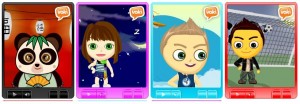
Digital collages are a fun way to integrate art into a lesson plan. They can be an authentic assessment option since many students think visually. Before CollageIt, the tools to create digital collages were cumbersome and/or blocked by school filter.
CollageIt by Pearl Mountain Software is an easy download with no Active-X or other bothersome add-ins to combat. In three easy steps, a digital collage can be created. Aesthetic touches include multiple layout and rotation options.
I received CollageIt as a prize in Miguel Guhlin’s Around the Corner-MGuhlin.org blog contest. My previous attempts at online collaging involved sites with only four picture uploads for the free version and/or rendering and then retrieval of a link with huge pressure to purchase the finished project. Both options provided little in the way of classroom activity ease and integration.
Some fun uses for digital collages:
Digital essays: “What I did over summer vacation”, “My favorite book”, “My family tree”
Rebus Writings
Pictorial Timelines: chronicling sequences in Civil War battles, WW I & II battles, steps in an experiment, plot progression in a novel, lifecycles of cells, plants and animals,
Pictorial Summaries: Summaries of field trips, football season, band camp, chorus trip,
Visual Poetry: This is the one I like since many students have difficulty or perceive themselves as having difficulty with poetry.
Choose a poem, or let students self-select and read the poem. In teaching through the Bloom’s taxonomy of Knowledge and Application, students can also “list” words such as those from parts of speech and use them in a sentence. Unfamiliar words may be accompanied by a definition.
For this example I choose the poem “Happiness Will Sleep” by Miranda Claudius.
Happiness will sleep
in the still places:
in cups of tea, picture frames
and the smell of hope
that wraps around walls.
Next, students highlight the words that convey the meaning or symbols of a poem. To teach this skill in a basic form, ask students to highlight any nouns or adjectives and then choose which ones they think are the most important. In MS Word, you can use the highlighter tool or highlighters on standard hardcopy notebook paper. In teaching through the Bloom’s taxonomy, choosing the words applies to Analysis and Evaluation.
Next search visual representations for the words from pictures, uploaded pictures, or choose from a teacher-selected photo gallery as mentioned previously. Use the “Add” feature in CollageIt to include these pictures. Next, the fun of generating and choosing layout options begins. This coorelates to the Bloom’s taxonomy of Synthesis, Synthesis, and Evaluation.
NOTE: Students need to understand where to find the files to use for their collages. For young learners, a folder on the desktop or in My Documents simplifies this. (For techs and techno-geeks, please do not over-react to the mention of saving folders on desktops)
Here is a sample of one layout:
As a criteria, you may want to assign the number of pictures that may be included. This curtails, “Johnny one-shot” from submitting too early just to be done. You may also choose to assign a caption for students to write of the key phrases they are highlighting. To differentiate the assignment up a notch set a vocabulary criteria inclusion. For example, in this poem, “Tone” “Symbols” and “mood” could be criterion reference points.
Assessment with rubrics is highly recommended.
Your grading rubric could have these criteria points:
Number of Photographs to include: _____ (10 points)
Poem Choice Name and Text (20 points)
Collage Caption (50 points)
Number of Vocabulary words to include
Number of curricular concepts to include
Timeliness and Completeness submission (20 points)
CollageIt! Super duper fun and educational too!
BFF is an acronym for “Best Friend Forever.” These websites and tips are so good that they will become your technology BFFs!





